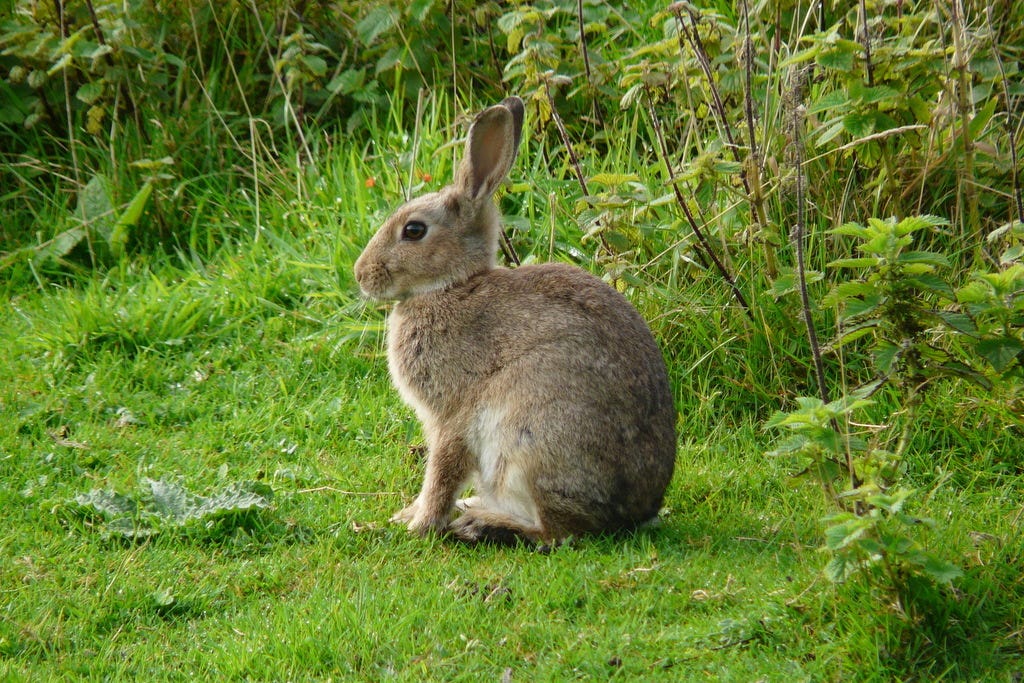I plan to celebrate New Year’s Eve by watching the match-ups between Ohio State and Georgia, and TCU and That Team Up North. But there is another New Year coming. Unlike the western New Year celebrated on January first each year, calculated by the earth’s travel around the Sun, the Chinese New Year is tied to the moon and falls on different dates each year. In 2023 that will occur on the 22nd of January.
2023 on the Chinese zodiac calendar is the year of the rabbit. Babies born in 2023, it is said, will want to figure things out for themselves, think before speaking, contemplate how to solve problems and be distinguished by elegance and sophistication. So, it will be the year of the rabbit, but which rabbit?
The rabbit family, Leporidae, includes 42 species of rabbit and 33 species of hare. Lumping in pika with 34 species, we have a lot of lagomorphs. The most obvious exemplar of the lagomorphs is the European rabbit, Oryctolagus cuniculus, from which more than 300 domestic breeds have been derived. Around the globe, domesticated rabbits are kept by farmers as livestock, from which meat, fur and wool are derived, by biomedical researchers as a model organism, and by hobbyists and fanciers who variously keep them as pets or breed them for show, selecting particular characteristics of size (from dwarf to giant), color, ear length and carriage (lop-eared or erect). The American Rabbit Breeders Association recognizes about fifty unique breeds, while the British Rabbit Council recognizes more than seventy-five.
The European rabbit, Oryctolagus cuniculus Linnaeus. Photo: Simon J. Tonge (2013). CC-by-3.0.
The European rabbit was named by Linnaeus in 1758, but the species was well-known for many preceding centuries. Pliny the Elder records in the first century BC that the Romans kept rabbits as a source of food in both hutches and in large walled-in leporaria where colonies were maintained. Pliny tells us that a Roman delicacy called laurices involved eating newborn and unborn rabbits. The beginnings of domestication and artificial breeding are not clear (as opposed to the two-thousand-year history of keeping captive rabbits), although it is known that in southern France, in the 12th century AD, monks were creating crosses. It was in the 19th century when rabbit fanciers exhibited breeds in Europe and the U.S. that the popularity of rabbits moved beyond a source of food and fibers. And it was in Victorian times that keeping rabbits as pets became popular.
The European rabbit is native to the Iberian Peninsula and Morocco and Algeria in northern Africa, but have been introduced by humans from the Ukraine in the east to Sweden in the north and as far away as Australia, New Zealand, and Chile. By the 1940s, the rabbit population in the UK was causing extensive damage to crops. Myxomatosis, a viral disease, was introduced resulting in the death of 99% of the population. Similar control measures were taken in Australia where the rabbit has no natural enemies and was causing great ecological damage.
A typical lifespan is three or four years for those which survive. But about 75% of the young die within their first three months of life. Pampered pets may live as long as ten years, and the record is about twelve years. In the wild, they are preyed upon by many predators from foxes and weasels to dogs and cats as well as birds of prey.
An easy way to distinguish rabbits from hare is in the common name hare. Their young are born with hair and good vision, while rabbits come into this world hairless and blind. Hare are solitary while many rabbits live in social groups. As a rule, hare are larger in size, their ears being larger and more elongate in shape and they have longer hind legs.
Linnaeus grouped rabbits and rodents together. Unlike rodents, rabbits have two sets of incisor teeth and were later separated and their similarities believed to have resulted from convergent evolution. Some molecular analyses suggested that rabbits are more closely related to primates and tree shrews than rodents, but other analyses and fossil discoveries have backed up a common lineage for lagomorphs and rodents.
I must say that I don’t buy into astrology, eastern or western. My Chinese zodiac sign is the snake. And although I’ve been called worse, I have not found 2, 8 and 9, my zodiac numbers, to be luckier than any other numbers, and my supposedly lucky flowers, the orchid and cactus, well, they pretty much refute the whole thing. I seem to consistently have bad luck keeping orchids alive and when I lived in Arizona I had numerous run-ins with cacti that were extremely painful and anything but lucky.
Further Reading
Asher, R.J. et al. (2005) Stem Lagomorpha and the antiquity of Glires. Science 307: 1091-1094.
Emmanuel, J.P.D. and D. Huchon (2004) Rabbits, if anything, are likely Glires. Molecular Phylogenetic Evolution 33: 922-935.
Esteves, P.J. et al. (2018) The wide utility of rabbits as models of human diseases. Experimental and Molecular Medicine 50: 1-10.
Graur, D., Duret, L., and M. Gouy (1996) Phylogenetic position of the order Lagomorpha (rabbits, hares and allies). Nature 379: 333-335.
Meng, J., Wyss, A.R., Dawson, M.R. and R.-J. Zhai (1994) Primitive fossil rodent from Inner Mongolia and its implications for mammalian phylogeny. Nature 370: 134-136.




